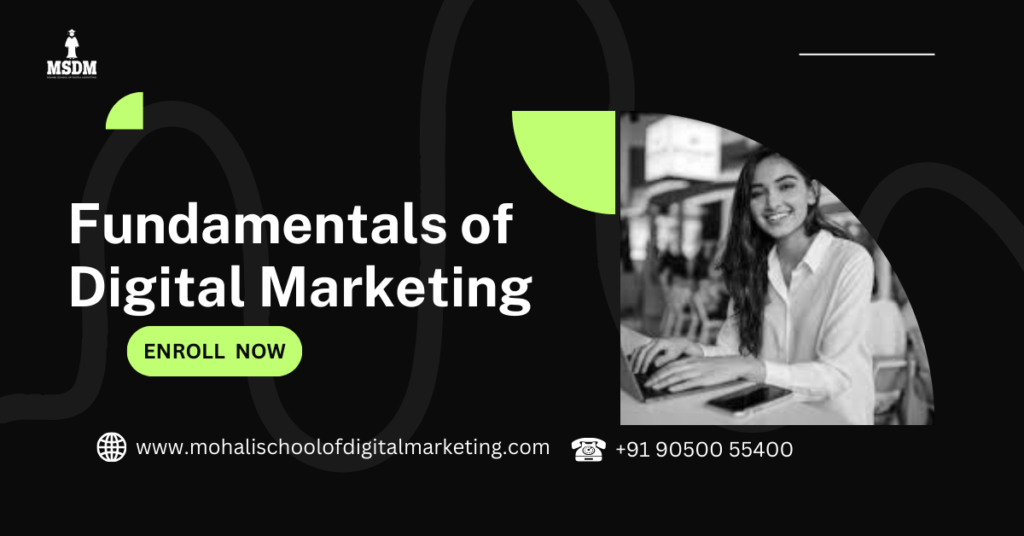Introduction:
In today’s technologically advanced, quickly changing business environment, digital marketing has become essential for companies looking to reach their target market and accomplish their goals. Knowing the foundations of digital marketing is essential for success, regardless of level of experience. The fundamentals of digital marketing will be covered in this article, providing you with a strong base from which to grow. Additionally, for those seeking in-depth knowledge and certification, the Mohali School of Digital Marketing (MSDM) offers comprehensive courses designed to equip you with the skills needed to thrive in the digital landscape.
What is Digital Marketing?
Any marketing initiative that makes use of an electronic device or the internet is referred to as digital marketing. Companies use digital platforms including websites, email, social media, and search engines to communicate with both present and potential clients. Digital marketing, in contrast to traditional marketing techniques, enables more accurate targeting, quantifiable outcomes, and real-time client interaction.
Essential Elements of Online and Digital Marketing :
Search Engine Optimization (SEO)
SEO is the process of making your website more search engine friendly so that it appears higher on search engine results pages (SERPs), resulting in an increase in organic (non-paid) traffic. It uses a number of strategies, such as technical SEO, off-page SEO, on-page SEO, and keyword research.
Keyword Research: Finding and focusing on relevant terms that prospective clients are searching.
On-page SEO: is the process of improving a single web page, including the HTML source code and content.
Off-Page SEO: Increasing the authority of your website by constructing backlinks from other respectable websites.
Technical SEO: Making sure there are no technical problems with your website that could prevent search engines from indexing it.
Marketing of Content
In order to draw in and keep the interest of a precisely defined audience, content marketing focuses on producing and disseminating worthwhile, timely, and consistent material. Motivating profitable consumer action is the aim.
Blogging: Consistently posting interesting and educational blog entries that solve the problems of your target audience.
Whitepapers and e-books: Providing comprehensive, downloadable information that adds value and exhibits knowledge.
Infographics: Producing easily understood and shared visual representations of information.
Video Content: Creating films that inform, enthrall, or motivate your viewers.
Social Media Marketing
Using social media networks to sell your business, communicate with customers, and generate website traffic is known as social media marketing. Every platform has distinct features and a different target demographic, therefore you need to adapt your strategy accordingly.
Facebook: Excellent for reaching a large audience and increasing brand recognition.
Instagram: Excellent for reaching younger audiences and sharing visual content.
LinkedIn: Good for professional networking and business-to-business sales.
Twitter: Good for sharing news and interacting in real time.
PPC (Pay Per Click) Advertising
PPC advertising enables companies to run advertisements on other websites, social media networks, and search engines. Consequently, advertisers are charged a fee every time someone clicks an ad. Google Ads is the most well-known PPC network; however, social media sites like Facebook and LinkedIn also provide strong PPC alternatives.
Keyword Targeting: Bidding on business-related keywords to have your adverts appear in search results is known as keyword targeting.
Audience Targeting: Reaching the correct people through interest-based, regional, and demographic targeting is known as audience targeting.
Ad Copy and Design: Creating enticing advertisements that promote clicks and conversions is known as ad copy and design.
Email Promotion
One of the best digital marketing tactics is still email marketing. It entails distributing niche emails to a subscriber list in order to cultivate leads, advertise goods, and uphold clientele.
List building: is the process of expanding your email list via lead magnets, landing sites, and sign-up forms.
Segmentation: Breaking up your email list into groups according to demographics, behavior, and preferences.
Automation: Creating email sequences that run automatically to provide subscribers with timely and pertinent content.
Analysis and Data Collection
Understanding the success of your digital marketing initiatives requires data analysis. A wealth of information is available on user behavior, website traffic, and conversion rates thanks to tools like Google Analytics.
Traffic Sources: Identify the sources of your visitors, including social media, organic search, and recommendation.
User Behavior: Watch how visitors utilize your website, what pages they visit, and how long they stay on it.
Conversion Tracking: Use sales, leads, and other important indicators to gauge the effectiveness of your promotional efforts.
The Value of a Comprehensive Strategy
The key to successful digital marketing is to take a comprehensive approach which involves several channels and techniques. Businesses can develop a unified and successful marketing strategy by fusing SEO, content marketing, social media, PPC, email marketing, and analytics. Every element works in concert with the others to create a more potent and all-encompassing plan.
Conclusion
The world of digital marketing is always changing, necessitating ongoing education and adjustment. Businesses may efficiently reach their target audience, drive engagement, and accomplish their goals by knowing the fundamentals and remaining up to date with the latest trends and tools. Purchasing a thorough education, like the programs provided by MSDM, can give you the groundwork and know-how required to succeed in the field of digital marketing. Accept the potential of digital marketing to seize fresh chances for expansion and achievement.

